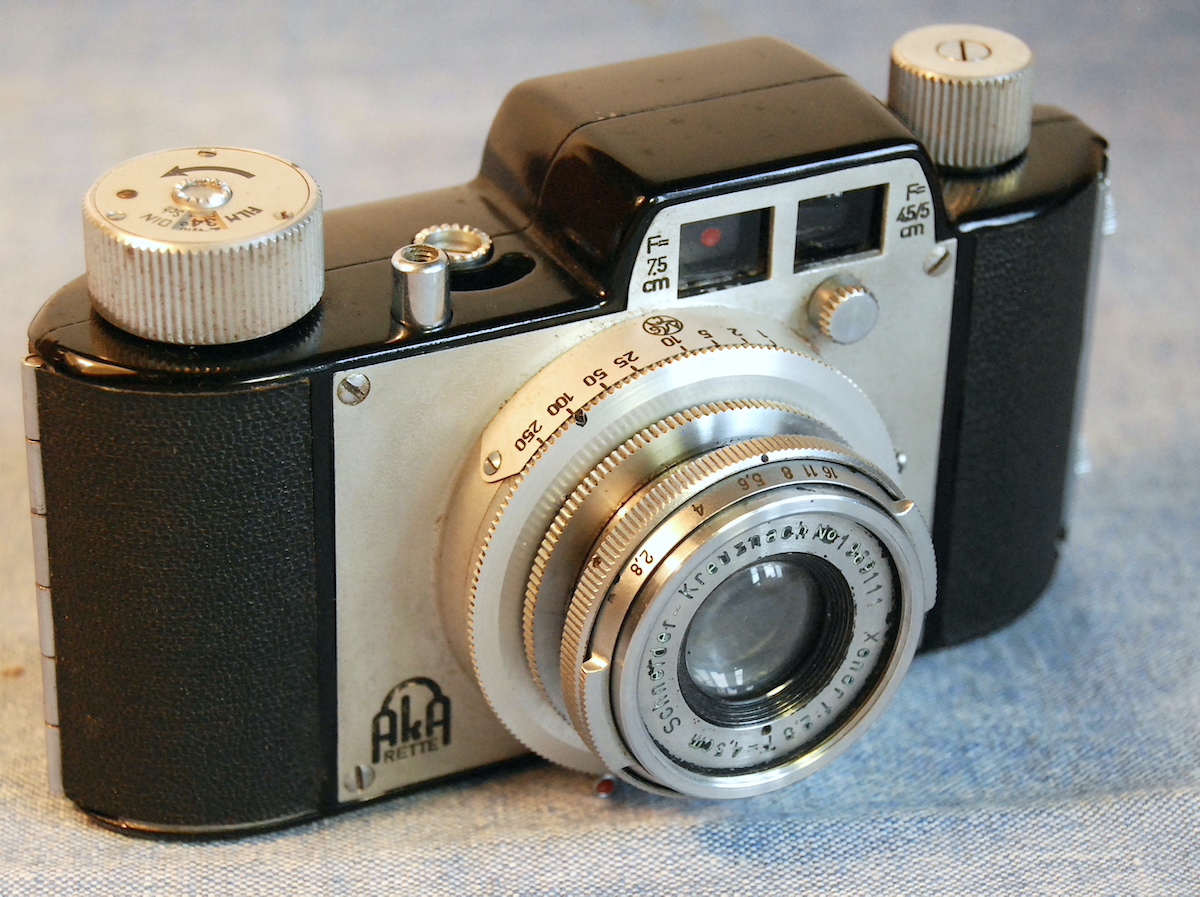 |
Akarette 1 from 1947 with 45mm Xenar
|
In an earlier post, I covered a general history of the Akarette/Akarelle cameras made by the German company of Apparate und Kamerabau GmbH. <http://wesloderandnikon.blogspot.com/2021/05/akas-akarette-and-akarelle-compact-35mm.html> Here I want to point out some features of the earliest Akarettes as well as display the range of quality Schneider lenses AkA offered for the camera at one time.
 |
Akarette with 7.5cm f3.8 Tele-Xenar. Finder covers both focal lengths.
|
This is an Akarette I. Serial number is 175, which would date it to early 1947—among the first cameras the company produced while still operating out of a hotel room in Wildbad in the Black Forest of southwest Germany. The earliest Akarettes used the 24x32 format—the same as the first Nikons and several other early Japanese 35mm cameras. However, despite its low number, this particular Akarette is in the 24x36 format. Fine with me. Easier to get slide film processed and mounted. Was it always 24x36? Was it modified later? Counter runs to 40 and the standard lens it came with a shorter 45mm, so who knows?
 |
Serial number behind back chart plate.
|
Serial numbers on early Akarettes are hard to find. The camera body consists of two cast aluminum shells with the back shell overlapping the front shell around the edges to make a nice light-tight body. The serial number is stamped on both shells. On the back it is located under the back plate chart with its wide range of exposure factors. You need to remove the chart to find the number. The number for the front shell is inside—behind the shutter/finder module You need to remove the module to see it. Why AkA hid the numbers this way is a question I cannot answer.
 |
Serial # behind shutter module in front casting.
|
Although the finish is a bit crude, in some ways it has held up better than the later Akarette II and Akarelles. No chromed top or bottom plates. Instead, the castings are directly finished in a glossy, hard, black enamel. The front plate is polished aluminum. Not pretty, but in better condition than the nickel-finished brass plates on later models that almost always show brassing. Shutter is an early Prontor with the Gauthier mark on top. Speeds from 1/250th down to one second plus B. A respectable shutter for 1947, and probably the best that Gauthier offered at that time. Frame counter is easy to see, which is more than I can say about later models.
The dual finder is clear and the rotation between 45/50 to 75 easy. I just wish it had an accessory shoe so I could mount a finder for the 35mm f3.5 Xenagon wide angle.
Sadly, the original lens for this camera is dirty, stiff and hazy. It is unusable without major surgery. It is also uncoated and most of the black paint is missing from the beauty ring. Still, I like the camera’s compactness and easy to use controls. If one can get used to zone-focusing and mounted a lens in better condition, this could be an easy camera to put in a coat pocket and head out to take pictures.
 |
Snowdrops, 45mm Xenar
|
 |
South view, 35mm Xenagon
|
 |
Linda splitting wood. 45mm Xenar
|
 |
Full range of Schneider lenses for the Akarette. 3.5cm Xenagon, 4.5cm Xenar, 5cm Xenon, 7.5cm Tele-Xenar, 9cm Tele-Xenar
|
AkA was determined to offer a camera with a full range of accessories and optics. All of the first lenses came from Schneider, an optical company capable of producing first-rate lenses. Here is a picture of the various Schneider lenses initially offered in the Akarette mount. Except for the 90mm lens, all are compact, solid, unit-focusing lenses. The 90mm f3.5 Tele-Xenar isn’t really that big, but compared to the other lenses, it’s a monster, twice the size and twice the weight of the 75 and with its focus direction the opposite of the others, it feels out-of-place.
Later lenses included front-element Xenars and optics from ISCO and other cheaper sources.








No comments:
Post a Comment